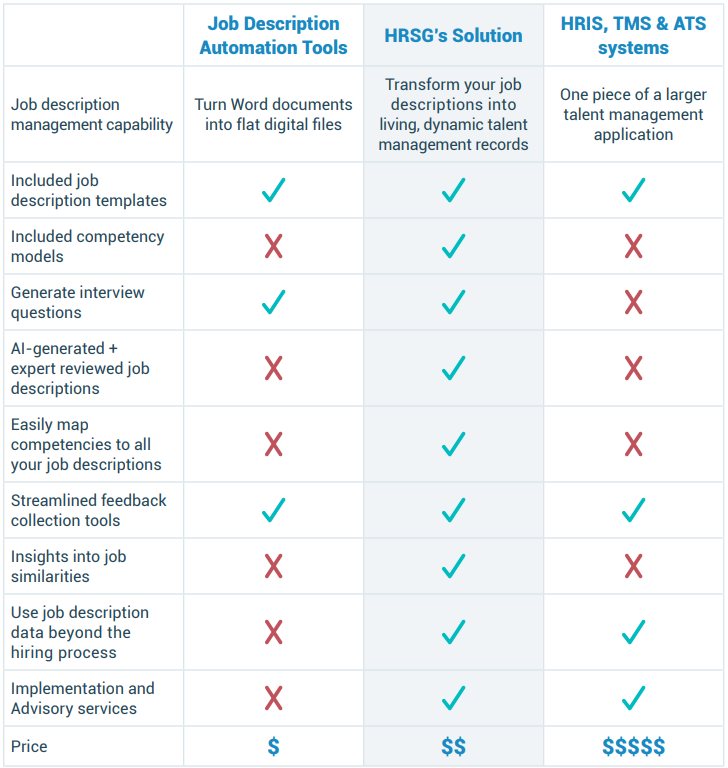HRSG Team
Introduction: The Changing World of Work
Some things have stayed the same, but a lot has changed in 2021. The disruptive effects of the COVID-19 pandemic have truly impacted many organizations and industries across the work
The same goes for the world of HR.
A 2020 survey from Gartner revealed some alarming insights:- 80% of the workforce, 92% of managers and 77% of senior leaders already felt poorly prepared for the future.
- A significant 40% of employees said they frequently completed responsibilities outside of their role.
Source: Build the Workforce You Need Post-COVID-19
If you’re reading this while working from home, you know all too well how much change has occurred in your life (both personal and professional).
Many organizations around the world were forced to shift to remote work during the pandemic.
According to Smallbizgenius, 18% of people work remotely full-time and more than 4.3 million people in the USA work remotely.
This has led many to ask critical questions about their own organizations:- Was our job description process prepared for this disruption?
- How will our job descriptions adapt to this “new remote world”?
- How can our job description process help us harness our in-house talent?
- What is “missing” from our current job description process?
These questions should lead to a critical assessment of your current job description process and the tools you use for your HR strategies.
If you’re in the HR field, think about all the ways that technology has become engrained in your daily working life, when compared to 5 or 10 years ago. If your current HR software is not robust enough, you could be missing out on actioning the untapped talent at your organization or better employee development opportunities.
There are 2 key factors that make job descriptions effective:- Quality: Job descriptions can become more valuable to HR if they have the right competencies (knowledge + skills + abilities) attached to them. They should also have the right responsibilities, education and certifications (relevant to the role in question).
- Other factors that affect the quality of a job description are updated content, validated content, standardized content across the organization and many more.
- Speed: More than 60% of respondents to a recent HRSG survey said they spend 2 hours or more crafting every job description that they work on. This is precious time that can be better directed towards other HR tasks.
When combined with the right competencies, job descriptions can become a foundational piece which can lead to employee career pathing (if used within the right tool or software solution).
Sadly, for all the technology that has emerged to make your life easier and allow you to spend your time more strategically, the world of job descriptions is still manually driven in many organizations.
Have you ever stopped and wondered “why?”
If you don’t have a software solution in place, you’re probably still facing the same old HR challenges with job descriptions and missing out on great opportunities to enhance your organization. We’ll get into those issues — whether you’ve thought about them a lot or not — in the next section.
But for now, take solace in the fact that there’s a solution out there to help, regardless of the size of your organization or the investment you have available.
Selecting the right software for your organization’s job descriptions is a big deal.
We want to spare you the headaches and long research hours by simplifying your life with this Buyer’s Guide to Job Description Software.

In a hurry? Jump straight to your section of interest by clicking its link below.
6 Signs that You Need a Better Job Description Solution
There are two main reasons why job descriptions, and the creation and management processes around them, have remained stagnant in many organizations.
 First, there’s an awareness factor at play. Even though you know that putting job descriptions together can be as fun as pulling teeth, maybe you hadn’t considered that many HR professionals are now
First, there’s an awareness factor at play. Even though you know that putting job descriptions together can be as fun as pulling teeth, maybe you hadn’t considered that many HR professionals are now
using better processes, fueled by a new wave of software options.
Maybe you just didn’t know that other options existed.
On the other side of the coin, there’s often a lack of strategic thinking when it comes to job descriptions. Job descriptions have so much potential to feed into better talent management processes and fluid employee lifecycles.
We’ll touch on both these areas throughout our report. Here are our top 6 signs that you need a better job description solution:
- Your job descriptions are only "surface level".
- You’re not making a distinction between ‘job description’ and ‘job posting.
- It takes too long to build and update your job descriptions.
- Your job descriptions are only updated when there’s a vacancy.
- Your job descriptions are not standardized.
- Your compliance process is disjointed.
Sign #1: Your job descriptions are only “surface level
A “surface level” job description is a job description that is only designed for hiring. Its content would likely be sourced from various sites via Google and lack standardization, validation and accuracy.
This type of job description is not updated on a regular basis and its data is scattered between Word files, shared drives, HRIS and ATS (little to no congruency).
Such job descriptions fail to capture the key behaviors needed for success in your organization.
There is more to your job descriptions than you think. Hiring is just the tip of the iceberg (so to speak). They can do so much more for your organization when applied within the right solution.
As opposed to a one-off, disposable document that’s only used during the hiring process, a proper job description has the potential to be used as a central, dynamic record that feeds into every piece
of your employees’ lifecycle.
Beyond the hiring process, you can use j ob descriptions as a dynamic record to assess employees; to develop learning plans; and as the foundation of visual career paths for your employees, that allow them to see how they measure up against the requirements for other potential jobs in your organization.
In the past, mapping competencies to job descriptions was a laborious, painful process. But now you can get a helping hand: CompetencyCore’s exclusive Competency Suggestion
Engine utilizes AI technology to help you add competencies to job descriptions in minutes. So you get all the benefits without the pain.
This is Step 1 on the road to unlocking the potential of job descriptions, and truly unifying your organization’s talent management lifecycle.
Sign #2: You're not making a distinction between 'job description' and 'job posting.'
Digitized job postings are, of course, a necessity to attract the right talent in the modern world of work.
So you go through the painstaking work of building them when there’s a vacancy, push them out on the internet, collect a few good candidates, and then lock the description away where they collect dust until the next vacancy.
But there’s an important distinction between ‘job posting’ and ‘job description’ that many people are still missing.
The difference between a job post and a job description is that a job post is based on a job description and is primarily used to promote a job opening to external/internal candidates
In contrast to a simple ‘job posting’, job descriptions are perhaps the most underutilized, overlooked tool in your HR arsenal.
Sign #3: It takes too long to build and update your job descriptions.
Job requirements are changing faster than ever — you know that, because you live it every day. It takes time to put together accurate descriptions (let alone update them regularly). And a lot of that
comes down to process.
In our recent State of Job Descriptions survey, almost 60% of respondents said that they rely on internal experts to help them build their job descriptions. If you have that expertise in-house, then great; it should be utilized. But in this fast-paced world, everyone’s busy; collecting input and managing versions can be like herding cats.
In that same survey, we found that the overwhelming majority of people pull job description content from a wide variety of sources, including internet searches, and straight up copying things off of other companies’ job posts.
This is no way to work.
Have a draft together? Pull it into the system and get to work.
Starting from scratch? Use one of our 1200+ job descriptions to give you a solid foundation, then edit to match your specific needs. These job descriptions are based on proprietary big data, reviewed by experts, and cover a wide range of industries and positions
Our embedded AI helps reduce the time it takes to choose the right content. Once you’ve got your draft in place, CompetencyCore makes it easy to collect input on your job description. Send the draft off to your key stakeholders and subject matter experts, and they leave their comments and revisions right within the tool. Accept them or reject them, and you’re on your way.
CompetencyCore statistic: Over 5,000 job descriptions have been created by our users.
Sign #4: Your job descriptions are only updated when there's a vacancy.
Believe it or not, some organizations still use paper copies and filing cabinets as the official repository of their job descriptions. Many others keep them in Word docs on shared servers.
In either case, it’s easy to understand why job descriptions tend to be ignored beyond the hiring process — they’re just a pain to find, and there’s no way to feed that valuable job data into the rest of
the employee lifecycle.
Due to the COVID-19 pandemic, many employees are now working remotely. If this is the case at your organization, is this change reflected in your current job descriptions?
What ends up happening is that most job descriptions are only reviewed and updated when there’s a vacancy that needs filling or a massive change in an industry (one which affects the work employees do). This raises several potential issues down the road.
Your job descriptions should serve as an official record of the responsibilities and skills requirements to perform the job successfully. So what happens when a particular position evolves over time — as the vast majority of all roles in the modern workplace tend to? The answer is that the current job description would no longer be a valid record of those requirements.
If you want to put serious talent management programs into place that engage your talent, keep them motivated, and show them areas for growth and development into other positions, it all starts with regularly reviewing and updating your company’s job descriptions.
Use our job description templates, generated by AI that’s crawled millions of data points, to start with job descriptions that reflect that modern world of work. Or use it to compare your existing job description. Access historical iterations of your job descriptions to track the evolution of the role over time. And easily collect input from subject matter experts to ensure
that your new versions accurately reflect the demands and requirements of the modern role.
CompetencyCore statistic: Over 4,000 job descriptions have been updated within CompetencyCore.
Sign #5: Your job descriptions are not standardized.
When companies grow beyond a few departments, job descriptions tend to be written in isolation from one team or department to the next.
Without standards in place, chaos can reign.
Good luck pushing back on that manager with a laundry list of extraneous requirements for a new role if there’s no actual standard format in your organization.
You also need to make sure that you’re hiring the same way across the board, and that starts with consistent job descriptions. A uniform job description format fosters the ability to improve your
hiring process: you’re more likely to have consistent standards across the organization, and it opens the door to a structured interview process that increases fairness and quality of hire.
Another key thing to keep in mind is how much standardization matters if you’re trying to build improved talent management processes for your employees. You simply can’t transpose, compare or contrast from one position to the next if the foundational job descriptions are different. Any activities based on your job descriptions are likely to be inconsistent from one department to the next. And forget about implementing any sort of career pathing program to foster employee growth into different roles in your organization.
while standardizing your company’s job descriptions.
With a standard format and consistent language used throughout all job descriptions, it opens up a new world of talent management possibilities to truly help all departments, managers and employees understand their role and pull in the same direction.
Sign #6: Your compliance process is disjointed, paper-based, or non-existent.
Over 40% of respondents in our research report, “The State of Job Descriptions in 2019”, said that compliance was a driving factor in they create job descriptions in the first place.
Compliant job descriptions require a consistent format, yes, and highly accurate content; but it’s about more than just that. It’s also about the paper-trail behind it: who was involved in determining
the requirements, how were they kept up-to-date, did employees acknowledge the accuracy of their job description.
Unfortunately, there are a lot of moving parts to this compliance process, and it all boils down to process. Without the right systems in place, establishing a repeatable process for your organization is next to impossible.
CompetencyCore’s collection of tools and features enable you to build that compliance process.
Version control: check ✔️. Trackable incumbent input into requirements: check✔️. Employee acknowledgement of job requirements: check✔️. For any job, CompetencyCore serves as the unified system you’ve been looking for to help manage your compliance process.
Section 3: Examining the Job Description Software Market
There are a wide variety of job description software tools on the market, catering to different size organizations and uses. Ultimately, the solution that you choose to consider will be driven by how exactly you want to use your job descriptions.
The landscape can be confusing to navigate, so let’s break it down into 3 main segments.
Job Description Automation Tools:
On the low end of the scale, there are tools that allow you to essentially do the bare minimum of digitizing your job descriptions. The costs of these solutions may run in the low hundreds of dollars.
Most of these tools offer templates pulled from publicly-accessible jobs databases like O*Net.
If you’re just looking for a bank of templates to use to create a few job descriptions a year, you’re better off sticking with publicly-accessible templates available on the internet. But if you have a
need for more regular job description creation, updating, and, most importantly, turning your job descriptions into more than just a single-use, stale document, then you’ll want to start looking at
purpose-built software.
HRIS, Talent Management Systems and Applicant Tracking Systems
At the other end of the spectrum, if you’re a large enterprise organization, you may require more of a comprehensive platform. This can take several forms and permutations, and some job description functionality can be found in certain human resource information systems (HRIS), talent management systems (TMS), and even applicant tracking system (ATS).
These types of solutions generally cover so much ground that they don’t go particularly deep on any one piece of functionality. They simply can’t afford to get into the granular details – they go “wide”
but not “deep.” So if improving your process, and getting more value out of your descriptions is a priority for you, these types of systems may not be the best place to do it.
While there are some great tools in this space, cost is a barrier to entry. For mid-sized organizations, there may be additional functionality that you have no intention of using but is lumped into the package as a way to increase the perceived value of the product.
HRSG's Solution: CompetencyCore
If you’re looking to build, manage and get more out of your job descriptions, a dedicated job description platform like CompetencyCore will make the most sense for your organization and give you the best bang for your buck.
If your company already has a bank of existing job descriptions, you can bring them into the software, map skills and behaviors (competencies) to the job descriptions, and build relevant interview guides in a matter of minutes. You can also build on our bank of 1200+ job descriptions to get a head start on your new descriptions.
But that’s really just the tip of the iceberg.
The key differentiator is that you can now easily deploy your organizational competencies via job descriptions which can directly feed into your employee career growth within your company. This unique software allows you to apply the power of competencies to truly upgrade your organization’s ability to strengthen and retain its workforce.
Here’s a deeper look at how CompetencyCore works:
Software Comparison:
What type of job description product is right for your needs? We’ve compiled the main tools and features that we get asked about by HR and talent management professionals into this chart for you.
Interested in learning more about a particular feature? Book your demo of CompetencyCore today!

Section 4: How to Build Better Job Descriptions, Faster
Fed up with your current job description process? Ready to start building better job descriptions that have a lasting impact on your HR programs?
CompetencyCore gives you the tools to elevate your process and empower your people across the talent management lifecycle.


Submit a Comment